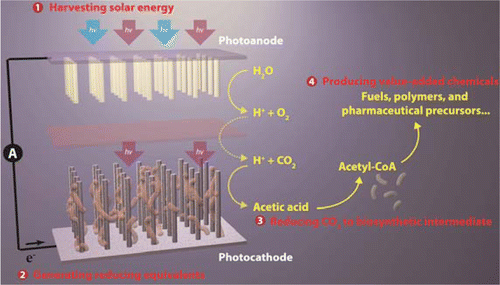Artificial photosynthesis could help make fuels, plastics and medicine

The global industrial sector accounts for more than half of the total energy used every year. Now scientists are inventing a new artificial photosynthetic system that could one day reduce industry's dependence on fossil fuel-derived energy by powering part of the sector with solar energy and bacteria. In the ACS journal Nano Letters, they describe a novel system that converts light and carbon dioxide into building blocks for plastics, pharmaceuticals and fuels—all without electricity.
Peidong Yang, Michelle C. Y. Chang, Christopher J. Chang and colleagues note that plants use photosynthesis to convert sunlight, water and carbon dioxide to make their own fuel in the form of carbohydrates. Globally, this natural process harvests 130 Terawatts of solar energy. If scientists could figure out how to harness just a fraction of that amount to make fuels and power industrial processes, they could dramatically cut our reliance on fossil fuels. So, Yang, Michelle Chang and Christopher Chang's teams wanted to contribute to these efforts.
The groups developed a stand-alone, nanowire array that captures light and with the help of bacteria, converts carbon dioxide into acetate. The bacteria directly interact with light-absorbing materials, which the researchers say is the first example of "microbial photoelectrosynthesis." Another kind of bacteria then transforms the acetate into chemical precursors that can be used to make a wide range of everyday products from antibiotics to paints.
More information: Nanowire-Bacteria Hybrids for Unassisted Solar Carbon Dioxide Fixation to Value-Added Chemicals, Nano Lett., Article ASAP. DOI: 10.1021/acs.nanolett.5b01254
Abstract
Direct solar-powered production of value-added chemicals from CO2 and H2O, a process that mimics natural photosynthesis, is of fundamental and practical interest. In natural photosynthesis, CO2 is first reduced to common biochemical building blocks using solar energy, which are subsequently used for the synthesis of the complex mixture of molecular products that form biomass. Here we report an artificial photosynthetic scheme that functions via a similar two-step process by developing a biocompatible light-capturing nanowire array that enables a direct interface with microbial systems. As a proof of principle, we demonstrate that a hybrid semiconductor nanowire–bacteria system can reduce CO2 at neutral pH to a wide array of chemical targets, such as fuels, polymers, and complex pharmaceutical precursors, using only solar energy input. The high-surface-area silicon nanowire array harvests light energy to provide reducing equivalents to the anaerobic bacterium, Sporomusa ovata, for the photoelectrochemical production of acetic acid under aerobic conditions (21% O2) with low overpotential (η < 200 mV), high Faradaic efficiency (up to 90%), and long-term stability (up to 200 h). The resulting acetate (∼6 g/L) can be activated to acetyl coenzyme A (acetyl-CoA) by genetically engineered Escherichia coli and used as a building block for a variety of value-added chemicals, such as n-butanol, polyhydroxybutyrate (PHB) polymer, and three different isoprenoid natural products. As such, interfacing biocompatible solid-state nanodevices with living systems provides a starting point for developing a programmable system of chemical synthesis entirely powered by sunlight.
Journal information: Nano Letters
Provided by American Chemical Society




















